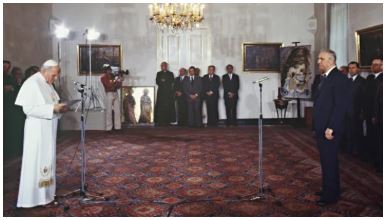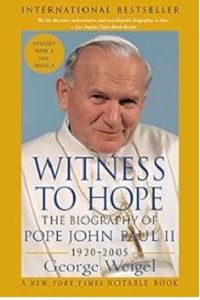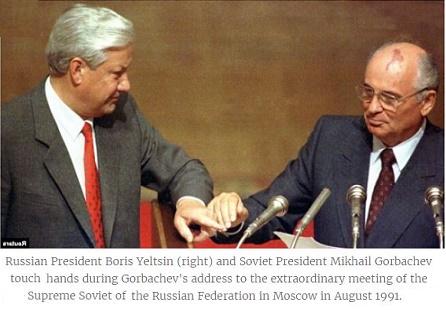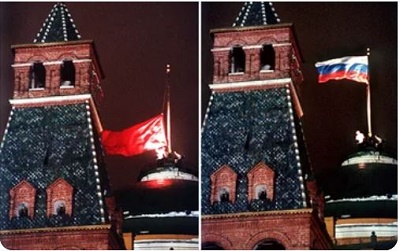Giáo Hoàng John Paul II đã góp phần vào sự sụp đổ của Liên Xô như thế nào?
John Burger/ Tuấn Lê
https://sachhiem.net/SACHNGOAI/FB/FBTuanLe01.php
 31-Oct-2023
31-Oct-2023
Khi Đức Gioan Phaolô II hôn đất tại sân bay Warsaw vào ngày 2 tháng 6 năm 1979, ông đã bắt đầu quá trình mà theo đó chủ nghĩa cộng sản ở Ba Lan – và cuối cùng là ở khắp mọi nơi – sẽ kết thúc (Giáo sư Lịch sử John Lewis Gaddis).

Ảnh https://aleteia.org/
Giáo Hoàng Gioan Phaolô II đã góp phần vào sự sụp đổ của chủ nghĩa cộng sản Liên Xô như thế nào?
Giáo Hoàng về Thăm Nước Cộng Sản Ba Lan kích động hàng chục Triệu Người Công giáo cuồng tín lật đổ chính quyền Cộng Sản Ba Lan. Vậy nước ta mời giáo hoàng sang thăm để làm gì hay mang lại tai họa cho dân tộc?
Ai đã làm sụp đổ Liên Xô và Đông Âu? Nhà Nước Cộng Sản Ba Lan đã mắc sai lầm to lớn dẫn đến sự Sụp Đổ của Ba Lan, Đông Âu và Liên Xô khi Nhà Nước Ba Lan cho ông Giáo Hoàng về thăm Ba Lan kích động hàng chục triệu con chiên cuồng đứng lên lật đổ chính quyền Cộng Sản Ba Lan. Thế rồi Ba Lan để Vatican can thiệp cài cắm người leo cao vào bộ máy chính quyền Ba Lan. Ba Lan nhượng bộ quá nhiều, dẫn tới sụp đổ vì Vatican.
Nước Ta đang bị Vatican cài cắm, mua chuộc rất nhiều ví trí chiến lược của Đảng như Bộ Giáo Dục, Báo Chí, Viện Lịch Sử, Tuyên giáo,...) Trong cuốn Chiến tranh Lạnh: Một lịch sử mới, Gaddis viết rằng “khi Đức Gioan Phaolô II hôn đất tại sân bay Warsaw vào ngày 2 tháng 6 năm 1979, ông đã bắt đầu quá trình mà theo đó chủ nghĩa cộng sản ở Ba Lan – và cuối cùng là ở khắp mọi nơi – sẽ kết thúc. ” Đám đông khổng lồ đã đến nghe ông và hàng triệu người khác đã nghe những lời của ông trên truyền hình.
Trong suốt bài giảng của Giáo Hoàng tại Quảng trường Chiến Thắng ở Warsaw vào ngày 2 tháng 6 năm 1979, đám đông đã đáp lại một cách nhịp nhàng: “Chúng tôi muốn Chúa, chúng tôi muốn Chúa, chúng tôi muốn Chúa trong gia đình, chúng tôi muốn Chúa trong trường học, chúng tôi muốn Chúa trong sách vở, chúng tôi muốn Chúa ơi, chúng con muốn Chúa. …”

Weigel ghi lại trong Witness to Hope: “Bảy giờ sau khi ông ấy đến, một sự thật quan trọng đã được làm sáng tỏ qua phản ứng của hàng triệu người Ba Lan đối với việc truyền giáo của John Paul”. “Ba Lan không phải là một nước cộng sản; Ba Lan là một quốc gia Công giáo bị gánh nặng bởi một nhà nước cộng sản.” (Giáo Hoàng đã nhồi sọ mọi xấu xa thuộc về Cộng Sản che dấu những tội ác tày trời mà công giáo gây ra cho Nhân Loại). Weigel viết. Công đoàn Đoàn kết Ba Lan, tổ chức đóng vai trò then chốt trong việc cuối cùng đánh bại chế độ ở Warsaw, đã ra đời sau đó.
Cuộc hành hương tiếp theo của Giáo hoàng tới Ba Lan vào năm 1983 đã giúp duy trì cuộc cách mạng. Và lần thứ ba, vào tháng 6 năm 1987, “nhằm chuẩn bị nền tảng cho thắng lợi của cách mạng và xác định những vấn đề cơ bản mà nước Ba Lan tự do trong tương lai." Tại quê hương của giáo hoàng, chính phủ đã công nhận Công đoàn Đoàn Kết một cách hợp pháp. Giữa cơn điên cuồng này, vào ngày 1 tháng 12 năm 1989, Gorbachev đến thăm John Paul II tại Vatican. Weigel tin rằng chuyến thăm là một “hành động đầu hàng”. Lá cờ hạ xuống.
Nhiều nước cộng hòa thuộc Liên Xô, như Estonia và Lithuania, đã tuyên bố độc lập khỏi Liên minh. Vào tháng 8 năm 1991, những người theo đường lối cộng sản cứng rắn và giới tinh hoa quân sự, thất vọng trước các biện pháp cải cách thất bại của Gorbachev, đã cố gắng lật đổ ông ta.

Gorbachev sống sót sau cuộc đảo chính, và John Paul II đã viết thư cho ông, bày tỏ hy vọng rằng ông sẽ có thể tiếp tục “nhiệm vụ to lớn của mình là đổi mới vật chất và tinh thần của Liên Xô”. Nhưng ngày hôm sau, Gorbachev từ chức Tổng Bí thư Đảng Cộng sản Liên Xô.

Ngày 25 tháng 12 (1991), Gorbachev từ chức và chuyển giao quyền lực tổng thống cho Boris Yeltsin. Tối hôm đó lúc 7:32 tối, biểu ngữ đỏ của Liên Xô được hạ xuống khỏi Điện Kremlin lần cuối cùng và thay thế bằng lá cờ ba màu của Nga.
Đức Gioan Phaolô II không bao giờ rời mắt khỏi Thiên Chúa. Ông ấy quỳ gối thách thức chủ nghĩa cộng sản và cầu nguyện với Chúa: ‘Ý Ngài được nên.’ Gaddis tin rằng trong khi “các hình thức quyền lực vật chất” mà Hoa Kỳ và Liên Xô nắm giữ, chẳng hạn như sức mạnh quân sự của họ, bắt đầu “mất hiệu lực” vào đầu những năm 1980, thì quyền lực thực sự lại “thuộc về các nhà lãnh đạo như John Paul II, người làm chủ những thứ vô hình - những phẩm chất như lòng dũng cảm, tài hùng biện, trí tưởng tượng, lòng quyết tâm và niềm tin - cho phép họ phơi bày sự khác biệt giữa những gì mọi người tin tưởng và hệ thống mà Chiến tranh Lạnh buộc họ phải sống."
________________
Bài liên quan:
- Lộ Trình Giải Thể Cộng Sản Của Giáo Hoàng John Paul II
_____________
Bản tin gốc:
How Pope John Paul II contributed to the fall of Soviet communism
https://aleteia.org/
John Burger - published on 12/23/21
On the 30th anniversary of the dissolution of the USSR, we look back at the dozen years when a formidable superpower gave way to a revolution of conscience.
As they did each evening, a small Catholic family in the Ukrainian Soviet Socialist Republic sat in their living room, watching the evening news. It was October 16, 1978, and the announcer said that that day at the Vatican, a bishop from Poland had been elected as the new pope of Rome. He took the name Pope John Paul II.
The family’s only child at the time was an eight-year-old named Sviatoslav Shevchuk. He and his family, though living under an atheistic regime, were well aware of the Vatican. Because their Church had been made illegal in 1946, they listened secretly to the Divine Liturgy broadcast each Sunday by Vatican Radio. Shevchuk would go on to study for the priesthood in a clandestine seminary. Today, as major archbishop of Kyiv-Halych, he is head of the worldwide Ukrainian Greek Catholic Church.
As he related the story to this writer in a 2019 interview, Shevchuk recalled that one of his grandparents commented on the news coming across the television that evening in 1978, “Something will be changing in the world.”
Most people believed that the Soviet empire, one of the world’s two superpowers, was virtually indestructible. But the parents and grandparents in the Shevchuk family recognized that a crack had developed.
“If someone from the Soviet, communist part of the world was picked to be the head of the Catholic Church, and they let him go, they are not all powerful,” the elders reasoned, according to Shevchuk. “Something will be changing. … From the TV you could perceive the emotion of fear, and from the audience the emotion of hope.”
Catholics and lovers of freedom throughout the Soviet empire would have to be patient for that change, and still there would be much suffering. But in retrospect, it’s astounding to think that it was just 13 years after Karol Wojtyla’s election as pope that the once-powerful Soviet Union crumbled.
Soviet leader Mikhail S. Gorbachev resigned as president of the USSR, and the red hammer-and-sickle flag was lowered for the last time over the Kremlin on December 25, 1991. This Christmas marks the 30th anniversary of the dissolution of the Union of Soviet Socialist Republics.
Though it was not Christmas Day in Russia, where the Orthodox celebrate the Nativity on January 7, according to the Julian calendar, the dramatic events must have been a sweet Christmas gift to people like Pope John Paul II, Ronald Reagan, Margaret Thatcher, Lech Walesa, and others who devoted much of their lives to the defeat of communism. Not to speak of the millions of Catholics who had been praying decades of rosaries – for decades – for the conversion of Russia.
And, for the Shevchuks and millions of people of faith throughout the Soviet sphere, there was restoration of religious freedom, which already had been growing slowly but surely.
Historians recognize that multiple factors contributed to the demise of the Soviet Union, including poor economic conditions in the Union itself. Reagan and Thatcher are regularly given credit for helping to push what was considered an inevitable downfall.
But Pope John Paul II also played a major and indispensable role, one that was primarily moral rather than political. His contribution to the downfall of Soviet communism is well documented in George Weigel’s two-volume biography of the pope, Witness to Hope and The End and the Beginning.
Nine days that changed the world
A central event in that history was the pope’s historic visit to his homeland in June of 1979 [In the photo above, John Paul is depicted speaking to Poland’s Communist Party chief Edward Gierek.] Why? Though Poland was not part of the USSR, it was ruled by a communist regime that answered to Moscow.
“He recognized and said, long before anyone else, this was on its face a spiritual conflict, that at the root the conflict between communism and the rest of the world was not about politics and wasn’t about military might; it was a spiritual conflict,” Barbara J. Elliott, Scholar in Residence and Assistant Professor in The Honors College at Houston Baptist University, said in a recent interview. “When he confronted it that way in 1979, he lit the long fuse that detonated 10 years later under the Berlin Wall. But he did it among his own people in Poland, reminding them who they were, that they were children of God, created with dignity and a responsibility, and that they were meant to be free in him. And that in resisting communism they had to do so responsibly, peacefully and overcoming evil with good.”
A former PBS reporter in Europe, Elliott worked with refugees in Germany coming from east of the Iron Curtain, and later traveled to Russia, East Germany, Poland, and Hungary to interview people who had resisted communism because of their faith. She told their stories in Candles Behind the Wall: Heroes of the Peaceful Revolution that Shattered Communism.
Growing up under communism
In examining the pope’s role in the downfall of Soviet communism, one shouldn’t overlook the obvious: that Karol Wojtyla was intimately familiar with it from living under the Marxist-Leninist regime that ruled his own country beginning in the wake of the Second World War.
As Lee Edwards, co-founder of the Victims of Communism Memorial Foundation, wrote, when comparing Reagan’s interest in the subject with Wojtyla’s, “In the late 1940s and early 1950s — when actor Ronald Reagan was fighting the communists in Hollywood — Fr. Wojtyla persistently rebutted efforts by Poland’s Stalinist rulers to reinvent the country’s history and culture. … In the 1960s — when Gov. Reagan was putting down radical-inspired violence on California’s campuses — Bishop Wojtyla reminded Poles that in their thousand-year history they often had ‘to break through to freedom from the underground. In the 1970s — when presidential candidate Reagan persisted in calling the Soviet Union “evil” and an empire — Cardinal Wojtyla reached out to Polish dissident intellectuals as part of his effort to forge, in the words of George Weigel, ‘a chain of cultural resistance’ to the communist regime. Wherever he went and wherever he was, the Polish cardinal fearlessly challenged what Vaclav Havel called “a culture of lies.” He effectively articulated a Christian alternative to the false humanism of communism.”
During the conclave that elected him pope, Cardinal Wojtyla read a Marxist philosophical journal during ballot counting, according to Weigel.
But the nine days he spent in his homeland turned out to be so consequential that even a secular historian like John Lewis Gaddis of Yale recognized it as a turning point. In The Cold War: A New History, Gaddis writes that “when John Paul II kissed the ground at the Warsaw airport on June 2, 1979, he began the process by which communism in Poland – and ultimately everywhere – would come to an end.”
Gaddis believes that while “the material forms of power” the United States and the Soviet Union embraced, such as their military strength, began to “lose their potency” by the early 1980s, real power rested “with leaders like John Paul II whose mastery of intangibles – of such qualities as courage, eloquence, imagination, determination, and faith – allowed them to expose disparities between what people believed and the system under which the Cold War obliged them to live. The gaps were most glaring in the Marxist-Leninist world: so much so that when fully revealed there was no way to close them other than to dismantle communism itself, and thereby end the Cold War.”
Poles, already proud to have one of their own sitting on the Throne of Peter, were ready to welcome their favorite son. Massive crowds turned out to hear him, and millions more listened to his words on television.
Throughout the pope’s sermon in Warsaw’s Victory Square on June 2, 1979, the crowd responded rhythmically: “We want God, we want God, we want God in the family, we want God in the schools, we want God in books, we want God, we want God. …”
“Seven hours after he had arrived, a crucial truth had been clarified by a million Poles’ response to John Paul’s evangelism,” Weigel notes in Witness to Hope. “Poland was not a communist country; Poland was a Catholic nation saddled with a communist state.”
A revolution of conscience
The 1979 pilgrimage ignited a revolution, Weigel writes. The Polish trade union Solidarity, which played a key role in eventually defeating the regime in Warsaw, was born in its wake. A subsequent papal pilgrimage to Poland, in 1983, helped keep the revolution alive. And a third, in June 1987, “was intended to prepare the ground for the revolution’s victory and identify the basic issues the free Poland of the future would face,” the author states.
Toward the end of the decade, the momentum increased sharply. Weigel says in Witness: “What had seemed immutable since World War II – Soviet hegemony over the world’s last great political empire, and the rule of communists within the vassal states of that empire – began to change with striking rapidity in April 1988.”
A slew of events transpired in that and the following year: the Soviets withdrew from Afghanistan. Gorbachev promised a new law on freedom of conscience. The Baltic republics made moves toward independence. Gorbachev announced major cuts in the Soviet military. Hungary allowed opposition parties. Czechoslovakia had its “Velvet Revolution.”
In the pope’s homeland, the government legally recognized Solidarity, whose party won big in Poland’s first semi-free elections. Later in 1989, Solidarity member Tadeusz Mazowiecki became the first non-communist prime minister of an east central European country in 40 years.
Meanwhile, East Germans taking refuge in Hungary were able to escape to the West when that country opened its border with Austria. Others flowed from Prague and Warsaw to West Germany. Finally, on November 9, 1989, the infamous Berlin Wall was opened for a free exchange of peoples between the East and West sectors of the old German capital.
In the midst of this frenzy, on December 1 of 1989, Gorbachev visited John Paul at the Vatican. In Weigel’s characterization, “the representative of the world’s greatest experiment in atheistic humanism [a social experiment meant to prove that man can organize himself without God, and that, indeed, belief in God stood in the way of complete human fulfillment], the Union of Soviet Socialist Republics, came to the Vatican to call on the world’s foremost representative of Christian humanism.”
Among other issues, the pope raised the issue of religious freedom for Greek Catholics in Ukraine, whose Church had been illegal since 1946.
Weigel believes the visit was an “act of surrender.” At the end of the visit, “Gorby,” as he was often called in the West, introduced his wife to the pontiff: “Raisa Maximovna, I have the honor to introduce the highest moral authority on earth.” To which he added, “… and he’s Slavic, like us!”
The flag comes down
Various republics of the USSR, such as Estonia and Lithuania, had been declaring independence from the Union. In August of 1991, communist hardliners and military elites, frustrated by Gorbachev’s failed reform measures, tried to overthrow him. Gorbachev survived the coup, and John Paul wrote to him, expressing his hope that he would be able to resume his “tremendous task for the material and spiritual renewal of the Soviet Union.” But the next day, Gorbachev resigned as General Secretary of the Communist Party of the Soviet Union.
Many republics, including Ukraine, declared independence in the following days and months. The secession of the Baltic states was recognized in September 1991.
In late 1991, the leaders of three of the Union’s founding republics – Russia, Ukraine and Belarus – formed the Commonwealth of Independent States, and 11 more republics joined them shortly thereafter. Kazakhstan was the last nation to leave the Soviet Union.
On December 25, Gorbachev resigned and turned over his presidential powers to Boris Yeltsin. That evening at 7:32 p.m., the Soviet red banner was lowered from the Kremlin for the last time and replaced with the Russian tricolor flag. The following day, Declaration 142-Н of the Supreme Soviet’s upper chamber, the Soviet of the Republics, recognized self-governing independence for the former Soviet republics, formally dissolving the Union.
The USSR had existed since 1922, five years after the Bolshevik Revolution and two years after Karol Wojtyla’s birth in Wadowice, Poland.
“It might be tempting to characterize Pope John Paul II as the political foe who vanquished communism. But that would be untrue,” Barbara Elliott has written. “His position challenged communism in the metaphysical realm, not in the political arena. His message was never one advocating political positioning. Rather, he understood that the error of communism lay in its fundamental understanding of man, who is not merely a unit of labor engaged in a perpetual class struggle, as Marx claimed, but a creature made in the image of God, with a soul and an eternal destiny. John Paul II never took his eyes off God, his heart and mind like a compass pointing to true North. He encouraged people to love God more deeply, to cherish relationships with the people they love, and to obey God with abandon. He challenged communism on his knees, praying to God, ‘Thy will be done.’” 
John Burger
______________
PHỤ ĐÍNH:
Giáo Hoàng John Paul II đã giúp truyền cảm hứng cho quê hương mình chống lại chủ nghĩa Cộng sản
Nhà Nước Cộng Sản Ba Lan Sụp đổ sau khi Giáo hoàng thăm Ba Lan, bài học nào cho Việt Nam? Việt Nam không chịu học Ba Lan, Đông Âu, để cho Vatican đe dọa nghiêm trọng an ninh chủ quyền Quốc gia nếu mời Ông giáo hoàng Vatican sang thăm, và để cho Vatican lũng đoạn Báo Chí, Bộ Giáo dục, Viện Lịch Sử, Hội Nhà Văn, Viện Hàn Lâm Khoa học Việt Nam,... như hiện nay.
Lech Walesa (Người công giáo), người sáng lập phong trào Đoàn kết lật đổ chủ nghĩa cộng sản ở Ba Lan vào năm 1989-1990, đã nhắc lại sức mạnh của chuyến viếng thăm Warsaw của Giáo hoàng John Paul tới Warsaw vào năm 1979.
“Chúng tôi biết giáo hoàng đã đạt được những gì. Năm mươi phần trăm sự sụp đổ của chủ nghĩa cộng sản là do ông ấy làm”, Walesa nói hôm qua. "Hơn một năm sau khi ông ấy nói những lời này, chúng tôi đã có thể tổ chức 10 triệu người đình công, biểu tình và đàm phán. " Trước đó chúng tôi đã cố gắng, tôi đã cố gắng và chúng tôi không thể làm được. Đây là sự thật. Tất nhiên, chủ nghĩa cộng sản sẽ sụp đổ, nhưng muộn hơn rất nhiều và theo một cách đẫm máu. Ông ấy là một món quà từ thiên đường dành cho chúng tôi."
Giáo hoàng John Paul ban phép lành hoặc Rước lễ cho một Walesa đang quỳ gối, bản thân ông là một người Công giáo đi nhà thờ, đã làm suy yếu nhiều chế độ vô thần của Ba Lan. Và yếu tố Công giáo mạnh mẽ trong Đoàn kết đã giúp biến nó thành một phong trào bất bạo động.
Người Ba Lan nói rằng những chuyến viếng thăm và Thánh lễ đầy lôi cuốn của Đức Thánh Cha khiến người dân cảm nhận được sức mạnh tập thể của họ trong việc thách thức chính quyền.
Tadeusz Mazowiecki, một nhà hoạt động Đoàn kết và là thủ tướng được đầu tiên của Ba Lan sau khi chủ nghĩa cộng sản sụp đổ, cho biết Đức Giáo hoàng đã mang đến cho mọi người niềm tin rằng một cuộc đấu tranh hòa bình không phải là một giấc mơ viển vông. Giáo hoàng John Paul hóa ra có trong tay những lực lượng vượt xa sức tưởng tượng của những người cộng sản cai trị Ba Lan
Nguồn: Pope helped inspire his homeland to fight communism - baltimoresun.com
Trang Thời Sự






 Khác với dịp Giáng sinh năm ngoái, năm nay toàn bộ Nhà thờ Đức Bà đều được thắp sáng. Trước sự lung linh này, nhiều người đã thốt lên: "Đẹp quá"
Khác với dịp Giáng sinh năm ngoái, năm nay toàn bộ Nhà thờ Đức Bà đều được thắp sáng. Trước sự lung linh này, nhiều người đã thốt lên: "Đẹp quá" Nhưng có nhất thiết phải lấy sự “mờ hóa lịch sử” làm cầu nối “hàn gắn” vết thương chiến tranh?
Nhưng có nhất thiết phải lấy sự “mờ hóa lịch sử” làm cầu nối “hàn gắn” vết thương chiến tranh? Không chỉ nhớ đầy đủ tên họ của 3.000 người trong thôn, năng lực của anh Long còn được thể hiện trong đợt lũ lịch sử giữa tháng 11 vừa qua.
Không chỉ nhớ đầy đủ tên họ của 3.000 người trong thôn, năng lực của anh Long còn được thể hiện trong đợt lũ lịch sử giữa tháng 11 vừa qua.